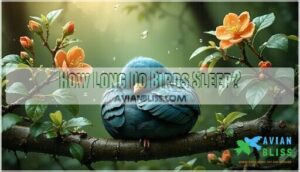This site is supported by our readers. We may earn a commission, at no cost to you, if you purchase through links.

Instead of lying down, they’ve mastered sleeping upright through a clever tendon system that locks their feet to branches.
Most birds catch their Z’s standing or perched, often tucking their heads under their wings for warmth.
Here’s where it gets wild: many species literally sleep with one eye open, keeping half their brain awake to watch for danger while the other half rests.
This "unihemispheric slow-wave sleep" lets them stay alert even while snoozing.
Waterbirds float and sleep, while some remarkable migrants actually grab microsecond naps mid-flight during thousand-mile journeys.
Their sleep cycles are brief but frequent, nothing like our deep slumber phases.
They have adapted to sleep in various ways, including floating and grabbing microsecond naps mid-flight, showcasing their ability to rest while still being alert for danger, and utilizing a unique system for rest.
Table Of Contents
- Key Takeaways
- How Do Birds Sleep?
- Do Birds Sleep Lying Down?
- Nocturnal Vs. Diurnal Sleep Patterns
- How Long Do Birds Sleep?
- Staying Warm While Sleeping
- Sleep Positions and Mechanisms
- Unusual Sleep Behaviors
- Migrating Bird Sleep Strategies
- Sleeping in Flight
- Frequently Asked Questions (FAQs)
- How long do birds sleep?
- What happens if a bird sleeps at night?
- How do birds ‘accumulate’ sleep?
- Where do backyard birds go at night?
- Do birds sleep lying down?
- How do birds sleep and not fall?
- How does a bird sleep while flying?
- Can birds dream during their sleep?
- Do birds snore or make noises while sleeping?
- How do birds choose their sleeping companions?
- Conclusion
Key Takeaways
- You’ll find birds never sleep lying down – they’ve mastered upright sleeping using special locking tendons that automatically grip branches, keeping them secure even during deep sleep without conscious effort.
- Birds literally sleep with one eye open through "unihemispheric slow-wave sleep" where half their brain rests while the other half stays alert for predators, allowing them to remain vigilant even while snoozing.
- You can’t compare bird sleep to human sleep cycles – they take short, frequent power naps throughout the day and night rather than one long sleep period, with some species sleeping just 3 hours during migration.
- Migrating birds catch microsecond naps while flying thousands of miles, using their split-brain sleep system to rest one hemisphere while the other navigates, proving they’ve adapted to sleep almost anywhere for survival.
How Do Birds Sleep?
Wonder drives our curiosity about bird sleep patterns and avian sleep habits.
You’ll discover that birds sleeping behavior differs dramatically from mammals.
Instead of lying down, birds roost upright using their roosting behaviors with special locking tendons that grip branches automatically.
Most birds tuck their heads under wing feathers for feather insulation and warmth.
Their unique brain activity allows unihemispheric slow-wave sleep, where one brain hemisphere rests while the other stays alert for predators.
Bird sleep behavior includes short power naps throughout day and night.
Sleep duration varies by species, season, and environment.
Some birds can even sleep mid-flight during migrations, making how birds sleep one of nature’s most remarkable adaptations for survival.
Birds also exhibit unique sleep patterns adaptations that enable them to rest while remaining vigilant for potential threats.
Do Birds Sleep Lying Down?
Birds don’t typically sleep lying down like mammals do. Instead, they’ve mastered upright slumber through specialized roosting behaviors. Most species prefer perched rest on branches, using locking tendons to maintain their grip while unconscious.
Here’s how different birds achieve feathered repose:
- Songbirds sleep upright on branches, tucking heads under wings for warmth
- Waterfowl float while sleeping, keeping one eye open for predators
- Ground birds like quails crouch in grass, using natural camouflage
- Owls roost in tree cavities during daylight hours
Bird sleep posture varies by species and environment. While birds sleep at night in various positions, they rarely use nests except when brooding. Bird sleep behavior prioritizes safety over comfort—birds sleep perching allows quick escapes from threats. This bird sleep position strategy keeps them alert while resting.
Birds often exhibit unique sleep adaptations to guarantee their survival in different environments.
Nocturnal Vs. Diurnal Sleep Patterns
While most birds don’t sleep lying down, their circadian rhythms and sleep cycles vary dramatically between species.
Nocturnal owls and nighthawks hunt after dark, using specialized night vision to thrive in darkness. They sleep during daylight hours when their light sensitivity kicks in.
Diurnal songbirds follow our schedule – active at sunrise, roosting at sunset. Many use unihemispheric slow-wave sleep (USWS), keeping one brain hemisphere alert while the other rests.
| Sleep Pattern | Active Period | Sleep Adaptations |
|---|---|---|
| Nocturnal | Night hunting/foraging | Daylight hiding, light sensitivity |
| Diurnal | Dawn to dusk activity | USWS, consolidated night sleep |
These opposing avian sleep patterns minimize competition for resources while maximizing survival strategies. Understanding normal sleep patterns is essential to identifying potential health issues in birds.
How Long Do Birds Sleep?
Sleep duration varies dramatically across bird species, much like how different people need different amounts of rest. Most bird sleep patterns involve 6-12 hours nightly, though this depends on their lifestyle and environment.
Avian sleep patterns show fascinating diversity:
- Songbirds typically sleep 10-12 hours, adjusting with seasonal daylight changes
- Nocturnal owls sleep up to 12 hours during daylight after nighttime hunting
- Migrating warblers reduce nightly rest to just 3 hours during peak travel periods
- Urban birds sleep 2-4 hours less than rural counterparts due to artificial lighting
Unlike humans with consistent schedules, bird sleep habits adapt constantly to survival needs, predator threats, and food availability. Understanding normal sleep patterns is essential for identifying potential health issues in birds.
Staying Warm While Sleeping
Cold nights present real challenges for sleeping birds. When temperatures drop, you’ll find these feathered creatures using remarkable thermal regulation strategies that put our winter gear to shame.
Feather insulation works like nature’s down jacket. Birds fluff their plumage to trap warm air pockets against their skin, creating multiple insulation layers. Down feathers closest to their body heat provide the most effective warmth retention. This physical adaptation can increase their insulation by 30-50%.
You’ll notice roosting behaviors change with temperature too. Birds huddle together in communal roosts, sharing body heat while reducing individual energy costs. Some species pack so tightly that outer birds rotate to interior positions throughout the night.
Fat insulation also plays a key role. Many birds build up fat reserves before cold seasons, providing both energy and extra insulation. Nesting materials get repurposed – birds often sleep in old nests or cavities lined with soft materials during harsh weather.
These bird sleep adaptations showcase how different bird sleep environments demand specific survival strategies, proving that staying warm while sleeping requires both behavioral flexibility and remarkable physical adaptations. Birds also employ a countercurrent heat exchange system to minimize heat loss in their feet.
Sleep Positions and Mechanisms
Ever noticed how a robin balances on a branch at night? That’s Perched Rest in action, thanks to a tendon-locking trick in their feet.
You’ll spot bird sleep positions like Feather Fluffing and Leg Tucking, keeping them warm and safe.
Roosting Behaviors get even cooler—some species use unihemispheric slowwave sleep, letting half their brain nap while the other half stays alert.
Brain Waves shift, and these bird sleep adaptations mean they can dream and rest without missing a beat.
Birds also exhibit unique sleep pattern adaptations that enable them to survive in various environments.
Unusual Sleep Behaviors
If you’ve ever wondered what makes bird sleep behaviors truly bizarre, you’re in for a treat. These feathered creatures have developed some mind-blowing bird sleep adaptations that’ll make you rethink everything you know about rest.
Unihemispheric Sleep allows birds to literally sleep with one eye open. Half their brain snoozes while the other half stays alert for predators. It’s like having a built-in security system that never takes a coffee break.
Here are three remarkable bird sleep behaviors you won’t believe:
- Torpor States – Hummingbirds drop their body temperature by 50°F and slow their heart rate from 1,260 to 50 beats per minute
- Microsleeps – Migrating birds catch quick 15-second power naps while flying thousands of miles
- Dream Patterns – Scientists discovered birds experience REM sleep cycles lasting just 9 seconds, with brain activity showing they might dream about singing
These extraordinary bird sleep positions and unihemispheric slowwave sleep patterns prove that nature’s solutions often surpass our wildest imagination. Understanding normal sleep patterns is essential to identifying potential health issues in birds.
Migrating Bird Sleep Strategies
Masters of migration face a unique challenge: catching sleep while crossing continents. These remarkable travelers have evolved extraordinary bird sleep adaptations to survive their epic journeys.
1. Sleep Deprivation Champions: Migratory birds dramatically reduce sleep from 8-12 hours to just 3 hours nightly, yet maintain sharp cognitive performance that would leave any insomniac jealous.
2. Brain Power Management: Using unihemispheric slow-wave sleep, they rest one brain hemisphere while the other navigates – imagine driving cross-country while half-asleep!
3. Microsleep Masters: Birds grab power naps lasting mere seconds during flight, accumulating hundreds of these tiny rest periods throughout their migration patterns to combat bird fatigue at altitude.
Many birds that migrate at night utilize nocturnal migration patterns to enhance their survival rates.
Sleeping in Flight
Birds literally catch micro-naps while soaring thousands of feet above Earth—nature’s most incredible power sleep.
Some birds have mastered flight sleep patterns that seem impossible—sleeping while soaring thousands of feet above ground.
Frigatebirds demonstrate remarkable aerial rest abilities, catching only 42 minutes of sleep daily during flight compared to 12 hours on land.
These mid air naps happen during gliding phases, not active flapping. Using wing locking mechanisms and unihemispheric slow-wave sleep, one brain hemisphere stays alert for navigation while the other rests.
This bird sleep adaptation prevents flying fatigue during ocean-crossing migrations, though it’s far less restorative than ground sleep.
Understanding bird sleep disorders is essential for maintaining their overall health and well-being.
Frequently Asked Questions (FAQs)
How long do birds sleep?
Most birds sleep 6-12 hours nightly, though this varies by species and season.
You’ll find they sleep less during summer breeding periods and more during winter when conserving energy becomes essential for survival.
What happens if a bird sleeps at night?
Like a master key opening restoration, nighttime sleep lets you recharge your feathered friend’s body and mind.
Birds use this downtime to consolidate memories, repair tissues, and prepare for tomorrow’s adventures while staying alert.
They utilize this period to rejuvenate, with nighttime sleep being crucial for their overall well-being.
How do birds ‘accumulate’ sleep?
You’ll naturally build up sleep through short bursts throughout the night, plus your brain uses unihemispheric slow-wave sleep to rest one hemisphere while staying alert for predators.
Where do backyard birds go at night?
Your backyard birds roost in dense shrubs, evergreen trees, tree cavities, and artificial shelters like birdhouses.
They choose spots that offer protection from predators and weather while staying close to food sources.
Do birds sleep lying down?
No, birds don’t sleep lying down like mammals.
You’ll see them sleep upright, perched on branches or standing.
They fluff their feathers, tuck their heads, and use locking tendons to stay secure.
How do birds sleep and not fall?
While you might think birds would plummet from branches, they’ve got a built-in safety feature.
When birds perch, special tendons in their legs automatically lock their feet around branches, creating a death grip that keeps them secure even during deep sleep.
How does a bird sleep while flying?
Birds use unihemispheric slow-wave sleep (USWS) to sleep while flying.
You’ll find one brain hemisphere rests while the other stays alert for navigation and predator detection, allowing continuous flight during migration.
Can birds dream during their sleep?
Imagine tiny feathered dreamers experiencing wild adventures while snoozing.
You’ll be amazed to know that research suggests birds do dream, with brain activity during REM sleep linked to singing and flying behaviors they practice while awake, which can include singing.
Do birds snore or make noises while sleeping?
You won’t typically hear birds snoring like humans do. Most birds sleep quietly, though some species make soft chirps, clicks, or gentle sounds while resting, especially during dream-like sleep phases.
How do birds choose their sleeping companions?
Unlike solitary sleepers, social birds you’ll find carefully select companions based on dominance hierarchies, family bonds, and safety needs.
Dominant birds claim warmer, safer interior positions while subordinates guard the vulnerable edges, highlighting the importance of safety needs.
Conclusion
Research shows that the theory about birds sleeping with "one eye open" is scientifically accurate – it’s called unihemispheric slow-wave sleep, where one brain hemisphere stays alert while the other rests.
Understanding how do birds sleep reveals nature’s incredible adaptations for survival.
You’ve discovered that birds don’t need beds or pillows like humans do.
Their unique sleep mechanisms – from locking tendons to microsecond flight naps – prove that evolution creates amazing solutions for rest and safety in the wild.









